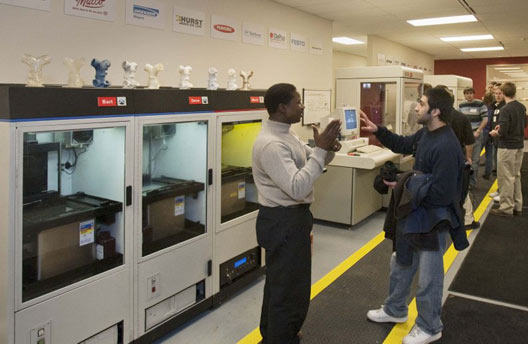
22 Nov Spotlight on the MSOE Rapid Prototyping Center
Researchers and clinicians within the CTSI have access to a unique and valuable resource for their prototyping needs.
Rapid prototyping allows for the automatic fabrication of an object directly from a Computer Aided Design (CAD) data source using manufacturing techniques. The Rapid Prototyping Center (RPC) at the Milwaukee School of Engineering (MSOE) was established 20 years ago with a grant from the National Science Foundation and industrial donations. RPC started off with only one machine and today has grown to house 10 world class machines. John Choren, P.E., Director of the Rapid Prototyping Center, says, “The greatest improvement over the past 20 years has been with the types of materials that are available.” Currently, the Center has access to 15 different types of materials with different properties ranging from clear, malleable, opaque, and even materials that can be utilized in a surgical suite.
RPC is a unique resource within southeast Wisconsin with cutting edge technology that can be utilized by clinical and translational researchers within CTSI. The Center can help researchers achieve prototypes more quickly, often in days rather than months, and is dedicated to the application of proven technologies to novel challenges. The RPC can be utilized for numerous medical research applications such as pre-surgical planning models, mechanical bone replicas, teaching aids and simulators, customized surgical implants, prosthetics and orthotics. The RPC has also assisted researchers with non-metallic devices for use in fMRI machines —like a hand bike device built to study brain activity during body movement —as well as the fabrication of robotic devices for use in assisting stroke patients.
The RPC helped facilitate numerous research projects in both industry and academia. For example, the RPC assisted researchers at Children’s Hospital of Wisconsin in creating a device that can be inserted into a person’s shoe to correct club foot. Club foot is a congenital deformity where one or both feet are pointed downward and rotated internally at the ankle. Prototypes of prosthetic sockets are being built at the Center for amputees. These prosthetic sockets can be tailored to exactly fit a particular individual’s leg. There are many other examples of the medical applications of rapid prototyping technology.
How can CTSI investigators access the RPC’s technology and services? Please contact the Director of the Center, John Choren, P.E. for more information.











